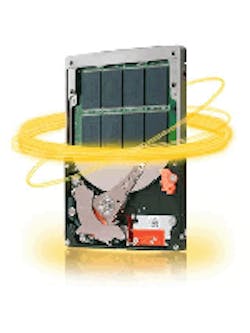The Momentus XT combines flash and hard drive
Adaptive Memory technology starts to stabilize after 3 iterations
Seagate took a new approach with its second generation hybrid hard drive. The first incarnation that mixed flash with rotating magnetic media required tight integration with the host operating system. In that case, the Windows operating system incorporated a device driver that worked hand-in-hand with the drive. This changes with the Momentus XT and its Adaptive Memory technology because the new drive requires no support from the host operating system allowing it to work well with any operating system.
The Momentus XT is a 7200 rpm drive with 4 Gbytes of flash storage and 32 Mbytes of DDR3 cache memory. The SATA interface handles a 3 Gbit/s transfer rate. The drives are available in 250, 320 and 500 Gbyte capacities.
The Adaptive Memory technology is essentially an advanced caching system used to determine what information will be kept in flash. The drive tracks reads and adjusts its storage patterns based on long term operation so it does not simply load up the latest information being read by the host. In general, this approach allows the drive to cache data that will help a system to boot more quickly or for a long running system to provide better application performance. Testing shows that performance can almost double after only three iterations which normally conforms to rebooting a system three times. Cache contents and performance improvements tends to stabilize after this point.
The system does not need to cache very large files because it can take advantage of the cache DRAM and the hard drive. For example, it can cache the initial sectors of a sequential block in flash and begin reading from the hard drive when the block is requested. This approach will not necessarily be optimal for all environments but it should work well for most desktop and laptop applications. The performance will be no worse than a conventional hard drive and will be better in general even for server environments although the Momentus XT drive targets laptops.
Write operations go directly to the hard drive so write performance is the same as for a conventional hard drive. Read operations use DRAM, flash and finally the hard drive when necessary. In general, this places its performance above a conventional hard drive for read operations but overall performance will depend upon how long a drive has been in use and how it has been used. This makes benchmarking a bit more difficult since short term testing will not show much difference versus a conventional drive. Longer duration, application oriented testing is more appropriate.
The drive does employ wear leveling techniques to extend the life of the flash strorage. This is transparent as is the usual caching subsystem. It is unlikely that the flash drive will wear out from general use before the magnetic storage portion gives out but if it does then the drive simply reverts to a conventional hard drive in terms of performance. The drives support SMART disk monitoring with proprietary extensions to check on the flash status.
The 2nd generation drive is applicable to embedded applications but its variable performance characteristics may make it more challenging to determine whether a system will always meet minimum performance requirements.
About the Author
William G. Wong
Senior Content Director - Electronic Design and Microwaves & RF
I am Editor of Electronic Design focusing on embedded, software, and systems. As Senior Content Director, I also manage Microwaves & RF and I work with a great team of editors to provide engineers, programmers, developers and technical managers with interesting and useful articles and videos on a regular basis. Check out our free newsletters to see the latest content.
You can send press releases for new products for possible coverage on the website. I am also interested in receiving contributed articles for publishing on our website. Use our template and send to me along with a signed release form.
Check out my blog, AltEmbedded on Electronic Design, as well as his latest articles on this site that are listed below.
You can visit my social media via these links:
- AltEmbedded on Electronic Design
- Bill Wong on Facebook
- @AltEmbedded on Twitter
- Bill Wong on LinkedIn
I earned a Bachelor of Electrical Engineering at the Georgia Institute of Technology and a Masters in Computer Science from Rutgers University. I still do a bit of programming using everything from C and C++ to Rust and Ada/SPARK. I do a bit of PHP programming for Drupal websites. I have posted a few Drupal modules.
I still get a hand on software and electronic hardware. Some of this can be found on our Kit Close-Up video series. You can also see me on many of our TechXchange Talk videos. I am interested in a range of projects from robotics to artificial intelligence.

